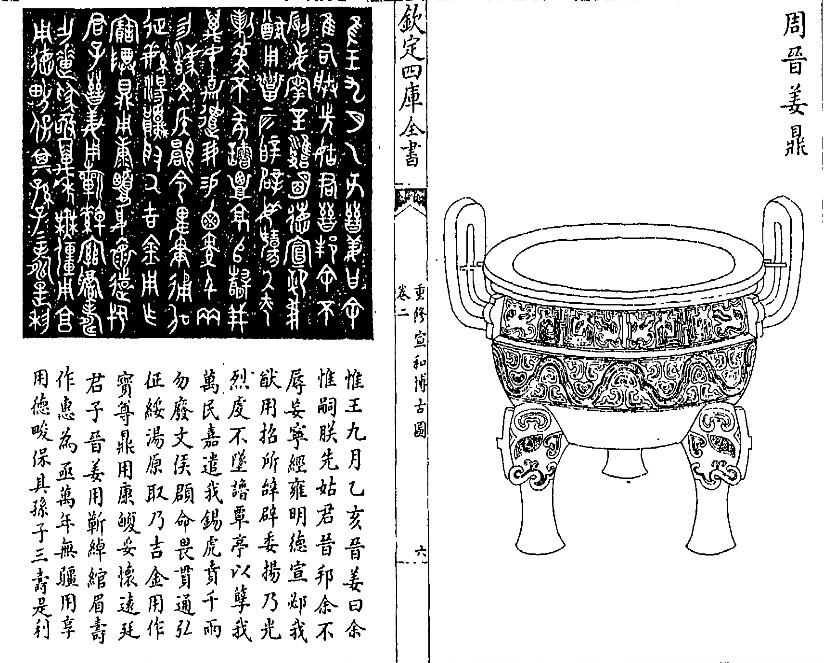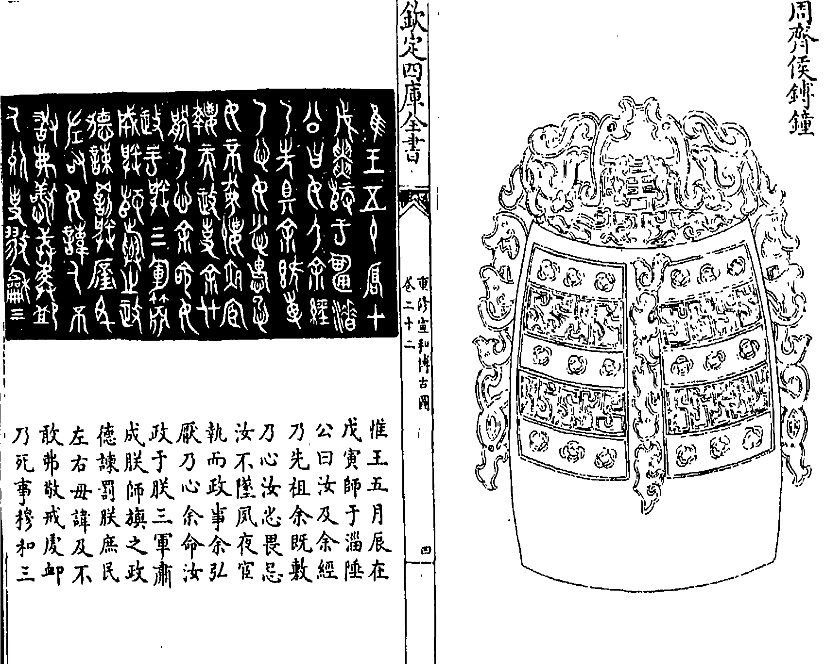Xuanhe bogu tu 宣和博古圖 "Illustrations on a wide ranges of antiques from the Xuanhe reign-period", abbreviated to Bogutu 博古圖, is a 30-juan long descriptive catalogue of antiques. It was compiled during the Song period 宋 (960-1279) by the minister and scholar Wang Fu 王黼 (1079-1126), courtesy name Jiangming 將明, who hailed from Xiangfu 祥符 (today's Kaifeng 開封, Henan). He obtained the jinshi degree during the Chongning reign-period 崇寧 (1102-1106), was known for his intelligence, and was therefore recommended by the Counsellor-in-chief He Zhi 何執 (1043-1116) for the post of editor in the palace library (jiaoshulang 校書郎). The next Counsellor, Cai Jing 蔡京 (1047-1126), promoted him to the post of left court gentleman for consultation (zuo jianyi dafu 左諫議大夫). Wang, in his craftiness, accused Cai of twenty capital crimes and, in 1120, became his successor. His policy was openly benevolent to the people, so he was known as the "wise counsellor" (xianxiang 賢相), yet in fact, he boundlessly enriched himself. He once conducted negotiations with the Jurchens of the Jin empire 金 (1115-1234), and sold back six cities in the region of Yanjing 燕京 (modern Beijing), which he declared as a great victory. He was rewarded with the title of Junior Mentor of the Heir Apparent (shaofu 少傅). When Emperor Qinzong 宋欽宗 (r. 1125-1126) succeeded to the throne, he dismissed Wang Fu as one of the "six bandit-ministers" (liu zei 六賊) of the age. Wang Fu wandered around in the vicinity of the capital Kaifeng, and was soon murdered in Yongqiu 雍丘.
The author of the Xuanhe bogu tu is in the Qing-period 清 (1644-1911) catalogue Junzhai dushu zhi 郡齋讀書志 called Wang Chu 王楚. This error was first corrected by Qing Zeng 錢曾 (1629-1701), author of the catalogue Dushu minqiu ji 讀書敏求記. This result was confirmed by the compilers of the imperial series Siku quanshu 四庫全書.
The book was begun in 1107 and finished in 1123, during the Xuanhe reign-period (1119-1125). It describes 839 objects from the imperial collection of the Xuanhe Hall 宣和殿. All antiques are drawn in illustrations and arranged in more than 50 categories of objects. These were tripods (ding 鼎, nai 鼐, 1-5), mugs (zun 尊, lei 罍, 6-7), kettles (yi 彝, zhou 舟, 8, you 卣, 9-11), vases (ping 瓶), jars (hu 壺, 12-13), beakers (jue 爵, 14, jia 斝 gu 觚, dou 斗, zhi 巵, zhi 觶, jue 角, bei 杯, dun 敦, 15-17), vessels with heavy bases (fu 簠, gui 𣪕/簋), cups (dou 豆), jars (fu 鋪, yan 甗, ding 錠, 18, li 鬲, fu 鍑, he 盉, 19, yan 盦, jiao 鐎, bu 瓿, ying 罌, bingjian 冰鑑, bingdou 冰斗), footed ladles (yi 匜), basins (yipan 匜盤, xi 洗, pen 盆, xuan 鋗, yu 杅, 20-21), bells (zhong 鐘, 22-25), lithophones (qing 磬), various types of bells (chun 錞, duo 鐸, zheng 鉦, nao 鐃, qi 戚 26), metal implements from chariots or crossbows, vanity cases, money or water jars for painting (nuji 弩機, dui 鐓, lian 奩, qian 錢, yandi 硯滴, tuoyuan 托轅, chengyuan 承轅, lushi 輅飾), and mirrors (jian 鑒, 28-30).
 |
| Tripod of the Jiang clan from Jin (Jin jiang ding 晉姜鼎). On the right an illustration of the vessel, to the upper left a rubbing of the inscription, and to the lower left the author's transcription/translation into contemporary Chinese characters. Siku quanshu edition of the Xuanhe bogu tu, juan 2, fol. 6.. |
 |
| First bell of the set of five of the Marquis of Qi (Qi hou fu 齊侯鎛). The picture shows just the beginning of the inscription and transcription. The full length of it is 492 characters. Juan 22, fol. 4. |
The objects date from between the late Shang 商 (17th-11th cent. BCE) through the Tang period 唐 (618-907). The book is one of the most important early collections of antique objects and is thus a demonstration of the interest of Song-period scholars in archaeology and the culture of their ancestors. The descriptions of the objects are very precise, and indicate height or diameter, volume or weight, the material used, and give information on the inscriptions and decorations. The book is one of the earliest attempts to decipher the bronze inscriptions on ritual vessels from the Shang and early Zhou periods, yet there are still many misinterpretations in the transcriptions.
The catalogue is very helpful in verifying or disproving statements in the transmitted version of the ritual text Sanlitu 三禮圖. It includes a great number of famous and outstanding vessels, such as the Jin jiang tripod 晉姜鼎 or the Qi hou bell 齊侯鎛 (first of a set of 5 bells, inscription only beginning, full length 492 characters). The terminology for ancient vessels was more or less standardized during the Song period and is still in use by archaeologists today.
The earliest surviving print dates from 1528 (by Jiang Yang 蔣颺 or 蔣暘), others from 1588 (by the Boru Studio 泊如齋), 1596 (Zheng Pu 鄭樸), 1600 (Wu Wanhua 吳萬化, Baogu Studio 寶古堂), and 1603 (Wu Gonghong 吳公宏). Jiang Yang reproduced an original print of the Yuanzhi reign-period 元至 (1264-1294, called Chongxiu Xuanhe bogu tu 重修宣和博古圖). The Baogu edition was in 1752 reproduced by Huang Sheng 黃晟 (Yizheng Studio 亦政堂). The Chongxiu Xuanhe bogu tu is also found in the Siku quanshu.